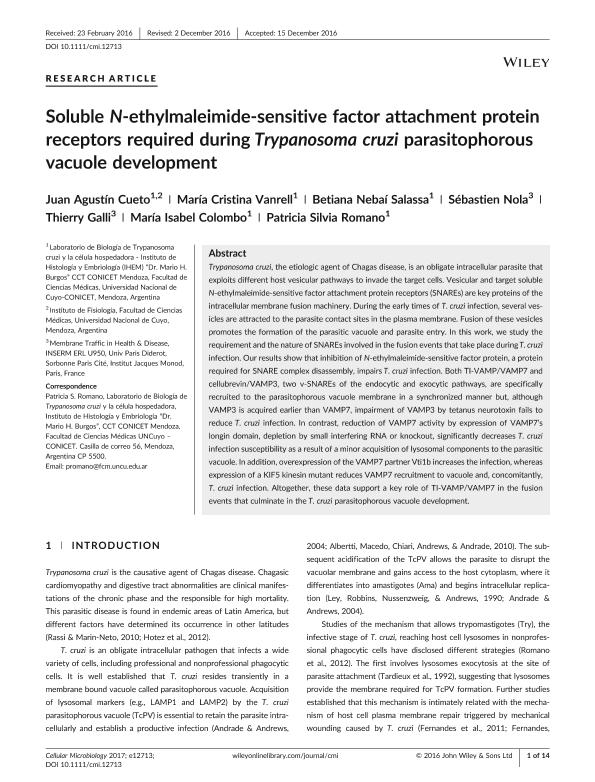Mostrar el registro sencillo del ítem
dc.contributor.author
Cueto, Juan Agustin

dc.contributor.author
Vanrell, Maria Cristina

dc.contributor.author
Salassa, Betiana Nebaí

dc.contributor.author
Nola, Sebastien
dc.contributor.author
Galli, Thierry
dc.contributor.author
Colombo, Maria Isabel

dc.contributor.author
Romano, Patricia Silvia

dc.date.available
2018-06-19T18:27:34Z
dc.date.issued
2017-06
dc.identifier.citation
Cueto, Juan Agustin; Vanrell, Maria Cristina; Salassa, Betiana Nebaí; Nola, Sebastien; Galli, Thierry; et al.; Soluble N-ethylmaleimide-sensitive factor attachment protein receptors required during Trypanosoma cruzi parasitophorous vacuole development; Wiley Blackwell Publishing, Inc; Cellular Microbiology (print); 19; 6; 6-2017; 1-14
dc.identifier.issn
1462-5814
dc.identifier.uri
http://hdl.handle.net/11336/49374
dc.description.abstract
Trypanosoma cruzi, the etiologic agent of Chagas disease, is an obligate intracellular parasite that exploits different host vesicular pathways to invade the target cells. Vesicular and target soluble N-ethylmaleimide-sensitive factor attachment protein receptors (SNAREs) are key proteins of the intracellular membrane fusion machinery. During the early times of T. cruzi infection, several vesicles are attracted to the parasite contact sites in the plasma membrane. Fusion of these vesicles promotes the formation of the parasitic vacuole and parasite entry. In this work, we study the requirement and the nature of SNAREs involved in the fusion events that take place during T. cruzi infection. Our results show that inhibition of N-ethylmaleimide-sensitive factor protein, a protein required for SNARE complex disassembly, impairs T. cruzi infection. Both TI-VAMP/VAMP7 and cellubrevin/VAMP3, two v-SNAREs of the endocytic and exocytic pathways, are specifically recruited to the parasitophorous vacuole membrane in a synchronized manner but, although VAMP3 is acquired earlier than VAMP7, impairment of VAMP3 by tetanus neurotoxin fails to reduce T. cruzi infection. In contrast, reduction of VAMP7 activity by expression of VAMP7's longin domain, depletion by small interfering RNA or knockout, significantly decreases T. cruzi infection susceptibility as a result of a minor acquisition of lysosomal components to the parasitic vacuole. In addition, overexpression of the VAMP7 partner Vti1b increases the infection, whereas expression of a KIF5 kinesin mutant reduces VAMP7 recruitment to vacuole and, concomitantly, T. cruzi infection. Altogether, these data support a key role of TI-VAMP/VAMP7 in the fusion events that culminate in the T. cruzi parasitophorous vacuole development.
dc.format
application/pdf
dc.language.iso
eng
dc.publisher
Wiley Blackwell Publishing, Inc

dc.rights
info:eu-repo/semantics/openAccess
dc.rights.uri
https://creativecommons.org/licenses/by-nc-sa/2.5/ar/
dc.subject
Ti-Vamp/Vamp7
dc.subject
Chagas Disease
dc.subject
Cellubrevin/Vamp3
dc.subject
Host Cell
dc.subject
Snares
dc.subject.classification
Otras Ciencias Biológicas

dc.subject.classification
Ciencias Biológicas

dc.subject.classification
CIENCIAS NATURALES Y EXACTAS

dc.title
Soluble N-ethylmaleimide-sensitive factor attachment protein receptors required during Trypanosoma cruzi parasitophorous vacuole development
dc.type
info:eu-repo/semantics/article
dc.type
info:ar-repo/semantics/artículo
dc.type
info:eu-repo/semantics/publishedVersion
dc.date.updated
2018-06-13T16:53:30Z
dc.journal.volume
19
dc.journal.number
6
dc.journal.pagination
1-14
dc.journal.pais
Reino Unido

dc.journal.ciudad
Londres
dc.description.fil
Fil: Cueto, Juan Agustin. Consejo Nacional de Investigaciones Científicas y Técnicas. Centro Científico Tecnológico Conicet - Mendoza. Instituto de Histología y Embriología de Mendoza Dr. Mario H. Burgos. Universidad Nacional de Cuyo. Facultad de Cienicas Médicas. Instituto de Histología y Embriología de Mendoza Dr. Mario H. Burgos; Argentina
dc.description.fil
Fil: Vanrell, Maria Cristina. Consejo Nacional de Investigaciones Científicas y Técnicas. Centro Científico Tecnológico Conicet - Mendoza. Instituto de Histología y Embriología de Mendoza Dr. Mario H. Burgos. Universidad Nacional de Cuyo. Facultad de Cienicas Médicas. Instituto de Histología y Embriología de Mendoza Dr. Mario H. Burgos; Argentina
dc.description.fil
Fil: Salassa, Betiana Nebaí. Consejo Nacional de Investigaciones Científicas y Técnicas. Centro Científico Tecnológico Conicet - Mendoza. Instituto de Histología y Embriología de Mendoza Dr. Mario H. Burgos. Universidad Nacional de Cuyo. Facultad de Cienicas Médicas. Instituto de Histología y Embriología de Mendoza Dr. Mario H. Burgos; Argentina
dc.description.fil
Fil: Nola, Sebastien. Université Paris Diderot - Paris 7; Francia
dc.description.fil
Fil: Galli, Thierry. Université Paris Diderot - Paris 7; Francia
dc.description.fil
Fil: Colombo, Maria Isabel. Consejo Nacional de Investigaciones Científicas y Técnicas. Centro Científico Tecnológico Conicet - Mendoza. Instituto de Histología y Embriología de Mendoza Dr. Mario H. Burgos. Universidad Nacional de Cuyo. Facultad de Cienicas Médicas. Instituto de Histología y Embriología de Mendoza Dr. Mario H. Burgos; Argentina
dc.description.fil
Fil: Romano, Patricia Silvia. Consejo Nacional de Investigaciones Científicas y Técnicas. Centro Científico Tecnológico Conicet - Mendoza. Instituto de Histología y Embriología de Mendoza Dr. Mario H. Burgos. Universidad Nacional de Cuyo. Facultad de Cienicas Médicas. Instituto de Histología y Embriología de Mendoza Dr. Mario H. Burgos; Argentina
dc.journal.title
Cellular Microbiology (print)

dc.relation.alternativeid
info:eu-repo/semantics/altIdentifier/doi/http://dx.doi.org/10.1111/cmi.12713
dc.relation.alternativeid
info:eu-repo/semantics/altIdentifier/url/https://onlinelibrary.wiley.com/doi/abs/10.1111/cmi.12713
Archivos asociados
